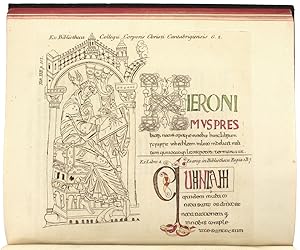About this Item
FIRST EDITION, occasional very faint foxing, woodcut portrait tailpiece of Gutenberg at end of Introduction, six tables in the text, 31 plates, of which four are printed on both sides (one in red, two in brown on verso), nine folding and seven partially hand-coloured, some light offsetting, pp. vii, xxv, 235 + 31 Plates, 4to, later calf, double fillet borders and corner leaf tools in blind to both panels, some surface abrasions, spine gilt lettered, red lettering piece, five raised bands hatched in blind with double fillet borders, small central lozenge tools in blind to empty compartments, spine rubbed with some surface loss, lower hinge rubbed with 5cm crack at foot but firm, all edges red, marbled endpapers, Walker & Son binders ticket and small modern bookplate (of the antiquarian bookseller Peter Stewart Young of Tillingham) to front pastedown, very good. Regarded by William Lowndes as the 'completest work on the subject of writing extant in this or any other language', 'The Origin and Progress of Writing' was considered 'an authoritative source for the history of writing well into the nineteenth century, and was last reprinted in 1876' (ODNB). Drawing from Astle's own extensive collection, the fine facsimile engravings were produced by Benjamin Thomas Pouncy, a draughtsman and engraver better known for his landscapes and topographical watercolours but whose work here is considered 'of exceptional quality' (ODNB). As described by Horace Walpole, 'In the paper office, there is a wight, called Thomas Astle, who lives like moths on old parchments' (letter to Rev. William Mason, Dec 21 1775 (Walpole's Correspondence, Yale Edition, 28.238)). Astle (1735 1803) was an archivist, antiquary, a noted collector of books and manuscripts, and a fellow of both the Society of Antiquaries and the Royal Society. In 1763 George Grenville, then prime minister and chancellor of the exchequer, nominated Astle alongside Sir Joseph Ayloffe and A. C. Ducarel to report on the public records held in the state paper office, which lead to a standing commission to superintend the materials held therein, and a similar commission to the same in the augmentation office. Subsequently, Astle was consulted by the House of Lords in regarding the publication of ancient parliamentary records, which resulted in the Lords' decision to publish the rolls of parliament - a slow undertaking, the six volumes of 'Rotuli parliamentorum, ut et petitiones, et placita in parliamento [1278 1503]' finally achieving publication in 1783, the same year that Astle was appointed Keeper of the Records. Astle amassed an outstanding private collection of charters, manuscripts and facsimiles as well as printed books, incorporating the collection of his father-in-law, the historian and clergyman Philip Morant, following Morant's death in 1770. On Astle's death, his manuscripts were offered to George Grenville, first Marquess of Buckingham and son of Astle's former employer, for the nominal sum of £500, thus forming the basis of the Stowe manuscripts collection now held by the British Library. (Lowndes I, 82; Alston III.850; ESTC T131273).
Seller Inventory # 72846
Contact seller
Report this item
